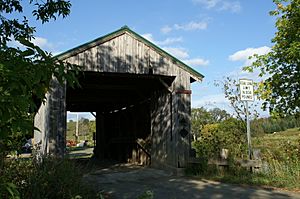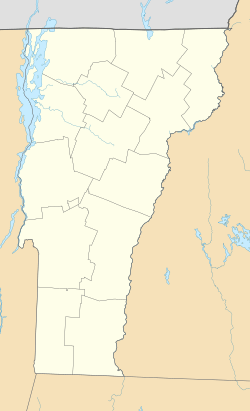Scribner Covered Bridge facts for kids
Quick facts for kids Scribner Covered Bridge |
|
|---|---|

Bridge in U.S. state of Vermont
|
|
| Carries | Automobile |
| Crosses | Gihon River |
| Locale | Johnson, Vermont |
| Maintained by | Town of Johnson |
| ID number | VT-08-09 |
| Characteristics | |
| Design | Covered, Queen post |
| Material | Wood |
| Total length | 47.8 ft (14.57 m) |
| Width | 12.4 ft (3.78 m) |
| Number of spans | 1 |
| Load limit | 8 tons |
| Clearance above | 8.25 ft (2.51 m) |
| History | |
| Constructed by | unknown |
| Construction end | unknown |
|
Scribner Covered Bridge
|
|
| Area | 1 acre (0.40 ha) |
| NRHP reference No. | 74000233 |
| Added to NRHP | October 1, 1974 |
The Scribner Covered Bridge is a special bridge in Johnson, Vermont. It's also called the Mudgett Covered Bridge. This historic covered bridge carries Rocky Road over the Gihon River. You can find it near State Route 100C in eastern Johnson.
This bridge is quite famous! It was added to the National Register of Historic Places in 1974. What makes it extra special is that it's one of the few covered bridges in Vermont that started as an open bridge. Later, a roof and sides were added to protect it.
Contents
What Does the Scribner Bridge Look Like?
The Scribner Covered Bridge is located in a quiet, country part of eastern Johnson. It helps Rocky Road cross the Gihon River, connecting Vermont Route 100C and Sinclair Road.
Bridge Design and Size
The bridge uses a design called a queen post truss. This means it has a special framework of wood beams that help it hold weight. It is about 48 feet (15 m) long, which is like four school buses parked end-to-end! The bridge is also 17.5 feet (5.3 m) wide, but the part cars drive on is about 13.5 feet (4.1 m) wide. This means it's a single-lane bridge.
Exterior Features
The bridge has a sloped metal roof that protects the wooden structure from rain and snow. Its outside walls are covered with vertical wooden boards. These boards also extend inside the openings where cars enter and exit. If you look closely, you'll see that the siding on the sides doesn't go all the way up to the roof. This leaves an open space near the top.
Bridge Foundation
The entire bridge rests on strong concrete supports called abutments. These were put in place in 1960. The wooden trusses (the main support beams) are a bit shorter than usual. They also don't have a lot of extra bracing inside. To make them stronger, metal plates have been added to the corners.
The History of the Scribner Bridge
We don't know exactly when the Scribner Covered Bridge was built or who built it. It's a bit of a mystery!
From Open to Covered
Experts have studied the bridge and found something interesting. They believe it was first built as an uncovered bridge. This type of bridge is called a Pony truss bridge. The trusses (the main support beams) are not very tall, which is a clue that it was once open. Old documents also helped prove this idea.
Repairs and Upgrades
In 1960, the bridge had some small repairs done. At that time, strong steel I beams were added underneath the road deck. These beams help make the bridge even more sturdy and safe for cars to cross today.



